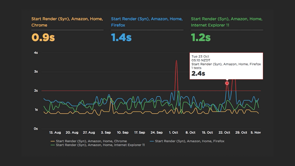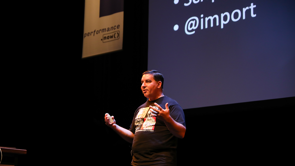
(audience applauds) - Thank you.
(audience member cheers) Wow, I did get a woo.
The coffee must be really good.
And speaking of coffee, I just thought this was a funny slide to have after the break.
This is me after three coffees, so i.e., right now. You noticed that the title of my talk in no way matches the slide that was just on before 'cause I'm always changing titles of things so I just thought this was, I don't know, I thought it was funny.
Thanks for that introduction, Tim.
That was so nice.
I love working with Tim so I just feel so lucky anytime I get a chance to cross paths and collaborate with him on anything.
So yeah, this is me.
You can find me on Twitter if you wanna reach out and ask any other questions after this talk or any time in the future.
I am the chief experience officer at SpeedCurve. What does that mean? I don't know.
Oh, a speaker wooed, that's awesome.
We're a web performance monitoring company. So we do synthetic and real user monitoring. As Tim mentioned, I help curate WPO stats, but shout-out to Tim for WPO stats 'cause he's actually the person who built it and just invited me to come along and help curate. If you're interested, it's a really great repository of case studies submitted by companies, so actual people who did the work where one of the criteria for submitting something to WPO stats and having it appear there is that there must be a demonstrable connection between what you did performance-wise and some kind of business or user experience impact. So it's just a really, really great resource. So yeah, so I work at SpeedCurve.
By far, the best, most fun part of my job is that I get to speak to a lot of different companies about performance and how they do performance and what their concerns are and their issues and the really creative solutions that they've come up with to push performance in their company and actually make things better and make things faster for their users.
These are some of the people that I talk with. I try to talk to companies at least once or twice a year so as you can imagine, that's a lot of conversations. I've been a speaker for over 2 1/2 years now so I reckon that's probably something like two or 300 conversations that I've had with different groups of people.
So there's way more than I can fit into a 45-minute talk but I'm gonna do my best.
And some of the things that I'm gonna talk about as well aren't going to be just specific to people that I've talked to it with but actually other case studies and people that I've read really inspiring things by online or listened to in various podcasts.
So going way back, I'm gonna see how well this, okay, that's good, it's clear.
Going way back, so Lara Hogan, she doesn't really do performance anymore and our community lost a bright, shining star when she became a management consultant, but former engineering lead at Etsy, VP of engineering at Kickstarter, really drove performance in both of those organizations. She wrote a really great book called "Designing for Performance" that she's kindly released most or all of the text to you online and you can find it if you go to that link. This quote really jumped out at me.
She did a whole chapter on performance culture, and I think in my reckoning, early days is one of the first people to come up with this term, performance culture, and I think a lot of us have really gravitated towards that because she articulated so many things that we realized were challenges that were not technical challenges to driving performance.
And as she says here, I'll read it for the benefit of anybody who can't see this, "The largest hurdles "to creating and maintaining stellar site performance "is the culture of your organization." I imagine that that's probably gonna resonate for a lot of you in this room.
She further said, "No matter the size or type of team, "it can be a challenge to educate, incentivize, "and empower those around you," and so, "Performance more often comes down "to a cultural challenge "rather than simply a technical one." I see cameras up, I'll just stop for a second. Don't you hate it, you go to take a picture and then it's like, ah, the next slide! (audience laughs) I'm sorry, that was mean.
So these are the three words that are the cornerstones of the talk that I wanna give today.
So the three words that Lara had mentioned: educate, incentivize, and empower people.
So how do you actually do that within an organization? How do you do it? Maybe it's easier in some ways with a smaller work but more challenging in other ways.
Every size of work has different issues.
Or maybe you work in a larger company where you're trying to actually get people thinking about performance throughout a company that has thousands of employees, how do you do that? I'm not gonna give you all the answers here 'cause I don't have all the answers but I'm gonna tell you what I know and hopefully point you towards some other resources that will help you learn a little bit more. And it's just an ongoing learning process, and one of the things I love about conferences like this is just how so many different people from so many different companies come to the table and there's so much sharing and cross-pollination of information, so if you have great tips on your own, share them in the Twitter hashtag or DM me or tweet at me, whatever.
I really love learning what people are actually doing out in the real world.
So basically, this is just this little cycle. I made this cheesy graphic .
It's the most corporate-looking graphic I think I've ever made.
Basically what you wanna do is you get people to care about performance in general, you get people to actually realize that performance matters in the larger sense, and then get people to care about the performance of your site, your web property in particular and then involve them in making things better, celebrate the wins, and then that continues a cycle of getting more people to care.
So before we get into things, I wanna jump in the way-back machine, I'm dating myself.
Who actually knows what this reference to? Okay. (laughs) So all the old people, okay.
Sorry, myself included.
So the way-back machine is a TV, a cartoon called "Mr. Peabody & Sherman".
It's sure is kind of a funny show.
Anyway, so we're gonna jump back in time to 2009 which is when I started to get really interested in performance, coming from a user experience background, and there was a really great case say at a company called Shopzilla which is now known as Connexity.
They did a great presentation at Velocity where they shared that they improved load time, they shaved it all the way down to 1.2 seconds, it was awesome for their business, they increased conversions by up to 12%, and 25% increase in traffic, although that's a little bit hard to quantify that it came from performance, it might have been other things, but the conversion thing, I can buy that.
But then what I thought was really interesting was that a year later, they came back to Velocity. Sorry, this is right.
I'm completely getting my timeline wrong.
So they shared that the average load time degraded to five seconds.
They took their eye off the ball and basically, users noticed and users were really unhappy, and the feedback that they got, they got a surprising amount of people writing them. You can kinda tell, if people are actually writing to you about the performance of your site, for every person that's writing you, there are thousands of people who aren't writing you, they're just like, I'm not coming back and they're just walking away. So the people writing them, saying I will not come back to this site again. It's just too slow.
They refocused on performance and as a result of that, they saw an increase in the conversion rate again. These are the areas that they highlighted when they talked about and very candidly talked about what happened. So they basically stopped measuring doing any ongoing front-end measurement.
They were just developing new features, as we all do. And these are all very relatable problems.
They had some third parties that were really poorly implemented, they waited too long to tackle performance problems, they waited for the problems to crop up rather than taking a ground-up approach to putting performance first as a feature and just relying on performance sprints to kinda like, oh, okay, let's just patch up these holes and hopefully things will get better.
Now, what I wanna get into these seven effective habits. So the first one is realizing, speaking of sprints, that performance isn't a sprint, it's a marathon. And it's kinda a cheesy metaphor so I got some cheesy photos to go with it.
These are people sprinting.
So sprinting, we're attracted to sprints.
As human beings, we love sprints because there's like, oh, I can see the end from here so that's really appealing. You may wear a funny costume, I don't know. You can kinda celebrate it and you're not taxed at the end.
This is what sprinting is like, yes, I did, it I'm victorious! Whereas a marathon is more like this.
And just to put it in perspective, these are both people who won their events, so it's like. (everyone laughs) So marathoning is challenging.
So I just had a curiosity, so I used to be pretty hardcore runner, distance running, marathon.
Has anyone ever actually trained for a marathon? Okay, so a few people.
So it's work to actually train for a marathon, so you actually complete the event required, you have to have a plan.
You have to have really clear goals and you can't think, oh, okay, I'm gonna get there in two weeks. No, no, no, okay, this week, I'm gonna run 10 miles in my long run.
Next week, I'm gonna run 13 miles on my long run. And you have to have a really well-formulated plan. You have to track yourself, if you care, the rigorous tracking.
And the nice thing about actual marathon is you can really have really fun, cool tools that you can download on your phone and you can get really persnickety about all the logging that you do and that's really great if you're just a super Type-A person.
The other great thing about marathoning is that there's a lot of community spirit that goes into it. You can train with groups, you run as part of a big pack, you find your tribe in terms of your pace, and there's a lot of community spirit that can happen in marathoning.
There's a lot of celebrating milestones.
You're just happy when it's that first day you do your 13-mile-long training run where at the end of the the actual marathon, wherever you run the event, it's a big celebration. And so in some ways, and I'm gonna abandon this metaphor because it's gonna start falling apart really quickly but the marathon training, in a lot of ways, has some correlations to performance.
Before I get into that though, I wanna talk about some of the other practices you have to have in place.
So one of the traits that I've observed when I talk to companies about performance is they have a champion higher up in the organization. So maybe that's you or maybe that's you to start, maybe you're the champion, but at some point, you're going to want to enlist somebody who is more senior in the org, who's maybe not involved in performance from a day-to-day basis but somebody who understands that there's value in investing in this, and then that person who's gonna have your back to help you drive, getting other higher-ups to invest in your teams, to give you the time and space that you need to work on what you need to work on and that sort of thing.
So having that champion is really important. And then you need to build a cross-disciplinary team. So what I mean by that is having people who aren't just performance engineers.
Obviously, if you've got a tribe of great performance engineers in your organization, that's amazing and you're lucky and you should just go home and be thankful every day, but you need more than that.
You need to have people from other parts of the organization, other teams, whether that's eCommerce teams or your ad team or your third-party team, your data science team. 'Cause awesome tools are not enough, and I say that as somebody who works with the most awesome tools in the world in my opinion.
I've seen people use even awesome tools like ours and fail because they did not have the right teams in place and the right processes in place to use those tools really well.
Yeah, I'm not quite done with the marathon thing yet. Sorry I lied earlier.
So kinda just had to drop a couple of bombs on you that might blow your mind so I'm glad you're already sitting.
So two things: one, the executives in your company aren't morons. They're actually intelligent people that you can enlist to care about performance. They're not against you.
And also, your marketing team isn't evil probably. Maybe they are, maybe you have this outlier organization where they're literally wearing horns and have pitchforks but they're not.
Simply put, everybody in your organization probably will care about performance if you teach them how to care about performance and if you make it relevant to them.
What you need to realize is that people, everyone who touches a page should care about the performance of the page. In my opinion, you shouldn't have people adding single lines of JavaScript or images or content or anything to the site if they don't understand how it affects the performance of your site.
Is this visible? Okay, cool.
It's very bright down here so I'm like, oh, when I turn around and look back up, I just wanna make sure that you can actually read what's up there. So a few things.
So these are some strategies that I think are really interesting ones.
So one, I've kinda touched on this, is embracing performance from the ground up. So realizing performance as a feature, nothing goes onto the page if it hasn't met whatever your performance criteria are. A strategy that I really like is just the idea of embedded engineers.
So if you have these disparate teams for your organization and you're fortunate enough to have performance engineers, developers, people who really care and are knowledgeable about performance, assign those people to work with those teams. Another thing that you can do, and this is a strategy that I'm gonna talk a little bit more about later 'cause it comes up in, I don't think that Tim has mentioned yet that he does a podcast called Chasing Waterfalls that you launched not that long ago and he's already got I think two episodes, two episodes that I've listened to anyways up. And one of the techniques that came up in one of them was just this idea of enlisting performance ambassadors. So it's the reverse idea of embedding engineers and teams. You can pull people from teams.
If you've got this core group of people, you can get them out there and put them in teams. But conversely, you can just go around and cherry-pick people from different teams in your org and say like, who cares enough to be the performance ambassador from that team and then once you have this team of performance ambassadors, then you can work together to consolidate what your standards are, what your practices are throughout the org. And a really important thing is just teaching people how to use, or at the very least, understand and decipher the charts and the different tools that you use.
So the thing that I see happening, and it's kind of kiss of death is realizing that in some organizations, people have inadvertently, 'cause I don't think anybody does this intentionally, they've made themselves a gatekeeper.
So they're the person who they own the tools, they own the charts, they own the reporting, they're that one person that everything goes through, and it's really easy to have that happen because you feel if you are that person, this is not a criticism or a judgment, that everybody else is too busy, nobody has time for this or you're the only person who really cares, you're the only champion for this.
So you don't wanna burden other people with this responsibility but the problem with being a gatekeeper is that as soon as you become a gatekeeper, what happens is if you get called into other tasks, performance drops off the radar.
If you get promoted, performance disappears in the org. If you leave the company, if you go on vacation, performance suffers. So it's really, really important to make sure that you're distributing the responsibility for performance.
So one way that you can do that is to define your goals as an organization. What are your performance goals? What do you care about? So this is from one of the Chasing Waterfalls podcast episodes with Reefath Rajali.
She commented that they first went to the engineering leaders, and then they went to the product leaders, and when her team talked to different people, their pitch and talking about performance was completely different.
Talking to product leaders, the focus was on business metrics, business numbers, how performance was gonna drive the business. But talking to engineering leaders, at least at PayPal, it was more about how are we making consumers happier? How are we driving consumer delight? So I think it's really important to understand that how you care about performance isn't going to be have somebody else cares about performance.
So you need to find out what people care about, and this, it takes a bit of work but it's very doable. The one amazing thing about all the different performance measurement tools that exist out there in the world is that we can now track so much stuff, maybe too much stuff but definitely a lot of things. And this is just a handful of metrics but if somebody is a money person in your organization, they're on the business side of things, they might care about how you rank up against your competitors or they might care about revenue or conversion rate. If somebody is in the SEO team, they might care about, well, SEO, or if they're in marketing, they care about maybe page views or time on site or things like that.
So the really awesome thing is that all of these metrics can be correlated to performance metrics.
You can take any of the performance metrics that you're accustomed to looking at, whether it's Start Render or First Contentful Paint or what have you, and you can correlate that with these happiness and business metrics.
And that's what you can use to motivate the people in your company.
So for example, if people care about business metrics, this is a competitive benchmarking chart where you can see a number of media sites and you can see, basically, the lines represent the different Start Render times for all these different properties.
This is gonna be a really motivating thing for probably somebody senior in your organization who just wants to make sure that you're faster than all your competitors, you show them this stack rank chart.
You can actually show this visualization in even more compelling ways like side-by-side filmstrip view which is really one of the awesome features in WebPageTest that you can generate filmstrips and you can see, oh, okay, well, we're really fast or we really suck, our competitors are much faster.
You can even generate side-by-side videos.
So again, another great WebPageTest feature where you can actually watch all of your property alongside your competitors' properties rendering side-by-side.
So the tools exist.
One thing I have to say about this feature, it's been around for years.
It's probably the single most motivating thing if you're early on trying to get people in your organization excited about performance, this is something that usually gets people to perk up and listen.
This is a correlation chart.
So again, for people who care about business metrics, you can look at your run data, and I don't know if you can make this out, the histogram is page load distribution so you can see most of the traffic low time is somewhere between one second and three seconds, and then there's a long tail there.
And then interestingly, you can see that conversions, our highest for the faster cohort of pages and then they drop down and they follow that long tail as they gets worse and worse. So this can be a really compelling graphic as well. If they care about user engagement.
So you can do the same thing and show people low time versus bounce rate. So you can see again, similar thing, the cohort of the histogram of low time distribution and then as pages get slower, bounce rate increases. For people who care about third parties, some really interesting stuff that's come up on the radar for a lot of people is just this idea that we can track various CPU metrics, and that CPU metrics actually have a lot to teach us about how third parties on our page are behaving and are they or aren't they hurting user experience? So you can look at metrics, like first, CPU idle which lets you know when the CPU is idle for a specific period of time, or first input delay which is how long it takes the page to respond to any actual user input to the page. And you can even track things like we have this happiness score that we do now at SpeedCurve where we actually take 10 metrics: Start Render, First Contentful Paint, a whole bunch of other things and bounce rate, and we divide up your traffic into what's the cohort of happy users versus okay users versus unhappy users.
And to be a happy user, your users have to have met all the different thresholds for these 10 performance metrics that we're tracking on. Or if they care about SEO, Lighthouse is really awesome.
You can track your SEO scores and you can look at the audits and see where you're going wrong SEO-wise.
If they care about third parties.
We've kinda talked about this before.
You can track third parties.
You can actually keep an eye on how they're performing. And this is going back to talking about CPU metrics. Just keep an eye on those fluctuations over time. And then I really love this one.
You can create correlation charts about pretty much anything.
If you're capturing metrics that are some type of user or have user behavior and at a performance metric, you can capture those. And so this, okay, you can see it here.
You can see that as CPU time increases, bounce rate increases.
So that's a really interesting way of just demonstrating to people, the CPU time is actually a illustration of how all the JavaScript on your page is performing and you can see that there's a relationship. And this chart isn't that stark but I've seen sometimes the CPU correlation charts where the bounce rate just goes way up as CPU time slows down.
So again, just a really good way of visualizing that to people so they understand that all the JavaScript on your pages actually does something to user behavior.
So okay, good.
That shows up.
So I just created this chart.
By no means is this meant to be exhausted.
These are merely suggestions.
I feel like I need to give a lot of caveats for this. But these are at least some good places to start from when you're investigating your own metrics. I talked about this.
For executives, you can show them competitive benchmarking or correlation charts.
Marketing, you can show them third-party performance correlation charts, things like image size, even if your marketing team is responsible for adding images to your pages, which they probably are. And then for your devs and engineers, they could care about a lot of things, so I didn't even wanna attempt to put that here. This is where you're gonna need to go deeper and actually engage with your teams and talk about and analyze the metrics that you're looking at and make sure that you're looking at the right ones. I did a whole talk about that actually last year right here on this stage, so you can go find that if you are really interested. And then the next type is just making people accountable. Accountability, it's funny, it sounds a little bit judgey, like you're accountable now.
But to me, I love being accountable.
It means that I actually have control over something. And in this otherwise meaningless chaotic random universe, I'd like to be accountable for a few things. It makes me feel like I have a center of gravity in my life. So performance budgets are a good way to make people accountable.
How many people here actually are currently using performance budgets on their pages? Okay, so a fair few which is great.
So what a performance budget is, and there's a lot of different ways you can implement these. Addy Osmani wrote a really great, very long post that I really recommend that you read to learn more about them.
And like I said, I did a talk about this last year. I have that Perf.Now.
But really, they're just various metrics, it could be milestone timings or quantity-based timings like image weight or rules-based timing like your Lighthouse scores or your user happiness score.
I'm sorry.
I'm gonna be less in even a second.
If anybody wants, still getting a shot of that. You've determined what metrics matter for your site. And ideally, like looking at things like correlation charts will help you pare that down.
And then you assign a value to that.
And again, going back to looking at a correlation chart, you can see like, oh, okay, well things plateau for us when we hit four seconds. So four seconds is our threshold.
So a good performance budget should show you what your budget is, when you go out of bounds, how long you're out of bounds, and then hopefully you get back on track and it'll show you that as well.
So this is an example of some performance budget charts from Zillow. They wrote a really great blog post and the link is here at the bottom of the slide. It's a few years old, and it's kinda one of the early case studies that I remember reading about, about a company actually putting performance budgets into practice.
And so they did a really great job of explaining how having performance budgets really helped them. This chart and the ones that I'm gonna show you on the next slide were used to illustrate how having performance budgets really helped them to triangulate on a problem. So the first thing they noticed was that suddenly they were out of bounds on their entire load time budget.
So bad, but that could mean anything.
So they looked at their other budgets and they saw that, okay, really quickly, the other areas were they're out of bounds were the number of image requests and total image size. So they realized that something had gotta gone rogue and if you read the blog post, you can see they quickly triangulated on the fact that it was just a few rogue images that have been added and they were able to quickly fix the problem and things back to normal.
So just a really simple example, but just how knowing what you need to track and then just tracking on it can help you fix problems really, really quickly. So just again, these are just suggestions for some metrics that you could look at for performance budgets, for your ops folks who wanna track back-end issues, time to first byte.
That's a good one.
For marketing folks, you can look at things like your Hero Rendering Times, how long it takes for Hero elements on your page to render, or Large Contentful Paint which is a new metric that I really like that just looks at, in the view port, what is the largest visual element? So whether it's an image or a video or your Lighthouse SEO score.
Or for devs and engineers, you might wanna look at Start Render or speed index or your Lighthouse performance score. Others as well, but these are, again, like I said earlier, a good jumping-off point.
You need to give people ownership.
And this is so, so, so important.
You can get all the way up to this point and if you don't hit this, then you can still go off the rails and find yourself really frustrated.
So this is another podcast that I recommend checking out is Vox Media being interviewed on the Responsive Web Design Podcast.
I can't remember who it was.
It was maybe Tin Avery talking about performance cops just earlier. So Lara Hogan coined this term performance janitors, performance cops.
You don't wanna be a performance cop.
You don't wanna set yourself up as that person or a group of people who are going around.
As Dan says, slapping people on the wrist saying, you built an article that broke the page size budget, take that down! So their goal when they set up themselves as a performance team was to consider themselves to be more like an in-house performance consultancy to provide best practices, guides, guidance to be just a known resource within the company. You're gonna have much greater success longterm. If you have people knowing that you're there as a resource but ultimately understanding performance budgets and setting their own targets based on what they know because I think anybody who's been doing performance for a long time will tell you, none of us know everything.
So people in other teams, it could be your marketing team executives, they might actually know something that you know that actually helps to define a better metric and a better number than what you would necessarily assign them. And you need to communicate.
Again, another great podcast episode in Chasing Waterfalls. Malek Hakim from Priceline basically said that, "We, as engineers, should learn how to show "the impact on anything that we do." And that's really, really important.
These aren't treasured secrets.
And you need to make sure that you're communicating that in a way that's meaningful for the audience. It's basically at the right place at the right time in the right format.
Otherwise, you end up in this situation where nobody's actually getting the message. So what that could look like.
So maybe, if your performance budget's set up, you can get alerted.
I see people using Slack and they have an entire Slack channel.
It's just set up for tracking performance budget alerts and then mitigating those.
You could have wall monitor where you actually just have some key charts and you're refreshing those charts on a daily basis, and it's up in an area of the office, it's high traffic, and people can see that.
And maybe it's charts that you care about, it could be your competitive benchmarking which could go well or badly depending on how you like to motivate people. So just really whatever you want to use to motivate people. And I see a lot more companies using wall monitors as a way to keep performance top of mind.
Maybe you just have all of your performance budgets just in a dashboard and you just get that you check out periodically and you see when something's in the red and you can drill down and fix the problem there. Maybe you get reports.
So this is just a screenshot of part of a weekly report that gets sent out where you just really simple measurements that show you this is where we are this week, this is where we were last week, did we get better or worse? And that's just something that gets automatically sent out maybe on a weekly basis. It's on right here? Do you see this slide of himself? I just grabbed this.
Maybe you do in-house meetups.
This is from the Toronto Web Performance Meetup. But maybe you do in-house meetups or you do lunch-and-learns or you do hackathons like with PayPal, the podcast episode that Tim did with Reefath. The way that they started to drive performance culture in PayPal was actually just to start with a hackathon and then take the results of that hackathon and show it around the organization and get people excited.
So actually having face-to-face contact with people is a really good thing.
And then making sure the message is getting out. I talked early about the right time, right place. So 24/7, wall monitors and dashboards, real-time for alerting.
Reports.
I don't know about you, I get a million emails a day, not actually a million but a lot and I do this and don't even read a lot of them because they're just things that I'm being CC-ed on or whatever.
So you wanna make sure that you're not inundating people and stuff, so having a really tight, meaningful weekly report no more than once a week I would hope.
And then meetups, hackathons, making that part of your culture, so maybe you do that on a regular basis like at least once a month.
And then celebrate! This is really important.
And I think that as Western world and this culture that we live in, and this just doesn't apply to tech and performance, I think just in life in general, we don't celebrate things enough and I think that we need to slow down, take pause, and celebrate all of our wins, big and small, and there's a lot of ways you can do that.
So you ring that bell, just kinda say, look it, I did a thing and it was a good thing! Pay attention, everyone.
Lara, I think a lot of people are familiar with this donut idea that every time Lara Hogan, when she was at Etsy, would have some kind of win, she would celebrate by getting a doughnut, and that doughnut just became a bit synonymous with performance wins for a lot of us.
You can celebrate the performance heroes in your company. So this is Etsy.
They would basically find somebody in the organization who wasn't necessarily a performance engineer. It was just somebody, say, in marketing who realized like, oh, you know what, I realized this image is actually really big and so I made it smaller and they fixed something, and sort of just to celebrate that in the company, so they're having regular performance heroes. Oh! We're just having a tweet.
This is a really great tweet.
Look, this is from The Telegraph UK.
Gareth tweeted this just basically that they improved TTI by 50% by making a few changes. And it got, you said, that's 104 likes from one tweet and it's just really nice.
I love seeing things like this show up in my feed and I will always retweet.
Or you can write a blog post, something was really successful and you have something to share.
The Telegraph has a really gray, actually, a tech blog on Medium that I encourage you to check out.
But a lot of companies have great tech blogs. And again, one of the things I love about this community is just the sharing that happens.
Score some easy wins, so that's a shout-out for Andy, wherever he is. Right over there, Andy.
For some of you, maybe you're passed this but for a lot of companies, I think there's still the dull, boring stuff that you can tackle like dealing with third-party scripts, dealing with images, extraneous code, deferring assets, all of these things that you can score some really quick wins and get people excited very early on and become a bit of a hero, especially for the new person in the org or the person who's just starting to champion a new initiative.
So for example, Priceline shared how all they did was they shaved 15 kilobytes off their logo which doesn't sound like much.
They ran an A/B test with the new logo, side-by-side. I love A/B tests.
And they found that they actually increased bookings by a pretty significant amount.
So that was just one little win with doing something that by all accounts would seem pretty basic and yet it was actually pretty substantial. So just to summarize, it's a marathon, not a sprint. Get champions, build teams, set goals, make people, including yourself, accountable, communicate, celebrate, and just bear in mind, there's no magic.
When I first got involved in performance, I would hear about companies like Etsy for example where it just seemed like wow, they have such an amazing performance culture and they're so fast and they're so on it, and I think a lot of people felt, it's easy to feel intimidated by that and feel like, well, I can't achieve that.
But really, Katie Sylor-Miller from Etsy who spoke at Perf.Now last year, she shared, and I was really impressed with her candor, she shared how the Etsy's management change, their structure change, teams change, some key people left who have been driving performance, and performance started to go off the rails for them and they realized they needed to get back on track. And so it's really no magic.
There's no secret sauce.
It's just having a plan, doing the work, and then being patient and realizing you need to actually, it can take months sometimes to just build culture, drive excitement in your organization.
So thank you very much.
It's been my pleasure to speak to you today. (audience applauds and cheers) - That was great, Tammy. - Thank you!
- I liked how you did some very precise, actionable do this or the timings on alerts and stuff like that. It was great.
You touched a little bit on the organizational aspect of performance engineers that are distributed or having performance ambassadors or the performance team. Can you talk a little bit about the performance team aspect? Should companies be aspiring to have a dedicated performance team? And if so, what is their role? Or do you think it's more efficient or effective to handle that structure in a different way? Basically, let's say that they're starting right now and they want to get to this point, do they build out a dedicated team? Do they start with the small groups? - When I think about the idea of a performance team, I think about it in really loose terms.
I think that the way we naturally gravitate towards thinking about it is a bunch of people all working in a shared space and they talk to each other daily and they're just like a pod.
But when I actually think about what feels more effective, especially in larger orgs, I actually kinda think that the whole ambassador model, having people out being distributed throughout the org but still having each other as a touch point, I think the really important thing is whatever you call it is just have something called performance in your organization so that people know that it even exists because labels help.
- Yeah, this is true.
Yeah, we joke a little bit about job titles and stuff like that but titles, labels do tend to stick inside of an organization.
- So whether you call it like it's your performance team, performance initiative, performance ambassadors, performance something, but to just have performance club, I don't know, if you want it to be more fun! (laughs) - Does that go for somebody who's coming back, like maybe they go back after the conference back to their company and there's nothing right now, does that go for them? Do they call themselves a performance club and invite people in? How do you start when you're that one first person who's really excited and wants to get this going? - The nice thing about coming to a conference like this is that can actually be your stepping stone to doing that because ideally, you learned a lot, you've got some good takeaways, and you can do maybe a lunch-and-learn, where it's like, this is what I learned at Perf.Now, and these are some of the takeaways and distill it down to do next steps.
These are the three things that I think we as an organization need to tackle next and use that as a jumping-off point for what you do next. - You mentioned a lot of visual ways of communicating performance which I'm a huge fan of, like doing a lot of, I'm sorry, the screen shots or the film strips or the dashboards. One of the things I think that somebody posed was sometimes, that's great for things like Start Render or paint things and visual metrics but we're also getting to a point where a lot of the metrics that we're running into, some of the stuff you showed like JavaScript CPU time or first input delay or long tasks have a huge impact on that experience but it's not a very easy thing to show visually. So you could look at a filmstrip and it looks great. Meanwhile, third parties or frameworks are destroying the main thread of the CPU, so have you seen any creative ways of trying to make that more apparent to people inside the organization who maybe don't have the technical foundation to just get it? - If I understand, you're asking how to help people understand maybe a little more abstract metrics like CPU metrics and things like that? - Yeah.
Is there a way to do for those metrics, make it apparent to the non-technical folks without making them read a waterfall or look at a browser thread, a CPU flame chart or something like that? How do we communicate that in a visual way? - Well, I think that correlation charts are a step in that direction.
CPU time, I've looked at a lot of correlation charts that look at CPU time versus bounce rate and there's a pretty strong correlation in almost all of them.
Sometimes, it's steeper than others.
Sometimes, depending on the site, it can be more flat. I think that's a really good one to start with because you don't wanna spend a long time talking about what the various CP metrics mean but if you just sit shorthand, CPU time, JavaScript, bad, CPU time, good, bounce rate, good, and just Tarzan it up.
(both laughing) - That's good.
Tarzan it up is something I wasn't expecting to hear so much during the conference but if that's-- (Tammy laughs) All right, well, thank you very much, Tammy. That was fantastic.
Again, Tammy.
(audience applauding) - Thanks!















